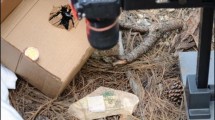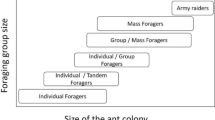Summary
A simple model is described wherein ant foragers choose a foraging sector as a function of the pheromone concentration associated with each sector. The choice is autocatalytic, as foragers that find food in a sector add to its pheromone. As a sector's food runs out, the foragers spontaneously switch to the adjacent sector. With increasing food abundance, the model passes from random foraging to the formation of a trail that rotates about the nest. The greater the abundance the more slowly the trail rotates until it finally becomes fixed on one sector. These results agree with experimental observations made on the harvester antMessor pergandei byBernstein (1975) andRissing andWheeler (1976), and reconcile an apparent contradiction between them.
Resume
On présente un modèle simple de choix du secteur de fourragement par des fourmis. Ce choix se fait en fonction de la quantité de phéromone associée à chaque secteur, et est autocatalytique puisque les fourrageuses qui trouvent de la nourriture dans un secteur y ajoutent de la phéromone. Quand la nourriture d'un secteur est épuisée, les fourrageuses transfèrent spontanément leur activité vers le secteur adjacent. Si la richesse en nourriture augmente, le modèle passe d'un fourragement aléatoire à la formation d'une piste qui tourne autour du nid. Plus la richesse est élevée, plus la piste tourne lentement, jusqu'à devenir figée en un secteur. Ces résultats correspondent aux observations faites sur la fourmiMessor pergandei parBernstein (1975),Rissing etWheeler (1976). reconcilient une apparente contradiction entre eux.
Similar content being viewed by others
References
Belic M.R., Skarka V., Deneubourg J.L., Lax M., 1986. — Mathematical model of honeycomb construction.J. Math. Biol., 24, 437–449.
Bernstein R., 1975. — Foraging strategies of ants in response to variable food density.Ecology, 56, 213–219.
Davidson D.W., 1977. — Foraging ecology and community organization in desert seed-eating ants.Ecology, 725–737.
Deangelis D.L., Post W.M., Travis C.C., 1986. —Positive Feedback In Natural Systems.Springer-Verlag, Berlin, 290 p.
Deneubourg J.L., 1977. — Application de l'ordre par fluctuations à la description de certaines étapes de construction du nid chez les termites.Insectes Soc., 24, 117–130.
Deneubourg J.L., Goss S., Pasteels J.M., Fresneau D., Lachaud J.P., 1987. —Self-organization mechanisms in ant societies (II): Learning to forage and division of labor. In:From Individual To Collective Behaviour In Social Insects (eds J.M. Pasteels and J.L. Deneubourg, 177–196, Birkhäuser, Basel.
Deneubourg J.L., Goss S., Franks N., Pasteels J.M., 1989a. — The blind leading the blind: Chemically mediated morphogenesis and army ant raid patterns.J. Ins. Behav. (in press).
Deneubourg J.L., Aron S., Goss S., Pasteels J.M., 1989b. — The self-organizing exploratory pattern of the Argentine ant.J. Ins. Behav. (in press).
Focardi S., Deneubourg J.L., Chelazzi G., 1985. — How shore morphology and orientation mechanisms can affect the spatial organization of intertidal molluscs.J. theor. Biol., 112, 771–782.
Goss S., Deneubourg J.L., 1988. — Autocatalysis as a source of synchronised rhythmical activity in social insects.Ins. Soc., 30, 310–315.
Haken H., 1983. —Synergetics.Springer Verlag, Berlin, 371 p.
Hölldobler B., 1974. — Home range orientation and territoriality in harvesting ants.Proc. Nat. Acad. Sci. USA, 71, 3274–3277.
Hölldobler B., Möglich M., 1980. — The foraging system ofPheidole militicida (Hymenoptera: Formicidae).Insectes Soc., 27, 237–264.
Keller E.F., Segel L.I., 1970. — Initiation of slime-mould aggregation viewed as an instability.J. Theor. Biol., 26, 399–415.
Martiel J.-L., Goldbeter A., 1987. — A model based on receptor desensitization for cyclic AMP signaling in Dictyostelium cells.Biophys. J., 52, 807–828.
May R.M., 1973. —Stability and Complexity in Model Ecosystems.Princeton University Press, Princeton, New Jersey, 235 pp.
Nicolis G., Prigogine I., 1977. —Self-Organization in Non-Equilibrium Systems, Wiley, New York, 491 p.
Okubo A., 1980. —Diffusion and Ecological Problems: Mathematical Models. Springer-Verlag, Berlin, 254 p.
Pasteels J.M., Deneubourg J.L., Goss S., 1987. — Self-organization mechanisms in ant societies (I): Trail recruitment to newly discovered food sources. In:From Individual To Collective Behaviour In Social Insects (eds. J.M. Pasteels and J.L. Deneubourg), 155–176, Birkhäuser, Basel.
Rissing S.W., Wheeler J., 1976. — Foraging responses ofVeromessor pergandei to changes in seed production.Pan.-Pac. Entomol., 52, 63–72.
Rissing S.W., 1981. — Foraging specialisations of individual seed-harvester ants.Behav. Ecol. Sociobiol., 9, 149–152.
Rissing S.W., 1987. — Annual cycles in worker size of the seed harvester antVeromessor pergandei (Hymenoptera: Formicidae).Behav. Ecol. Sociobiol., 20, 117–124.
Rissing S.W., 1988. — Group foraging dynamics of the desert seed-harvester antVeromessor pergandei (Mayr.). In:Advances in Myrmecology (ed. J.C. Trager), 347–353, E.J. Brill, Leiden.
Ward P., Zahavi A., 1973. — The importance of certain assemblages of birds as ‘information centres’ for food finding.Ibis, 115, 517–534.
Author information
Authors and Affiliations
Rights and permissions
About this article
Cite this article
Goss, S., Deneubourg, J.L. The self-organising clock pattern ofMessor pergandei (Formicidae, Myrmicinae). Ins. Soc 36, 339–347 (1989). https://doi.org/10.1007/BF02224885
Received:
Accepted:
Issue Date:
DOI: https://doi.org/10.1007/BF02224885




